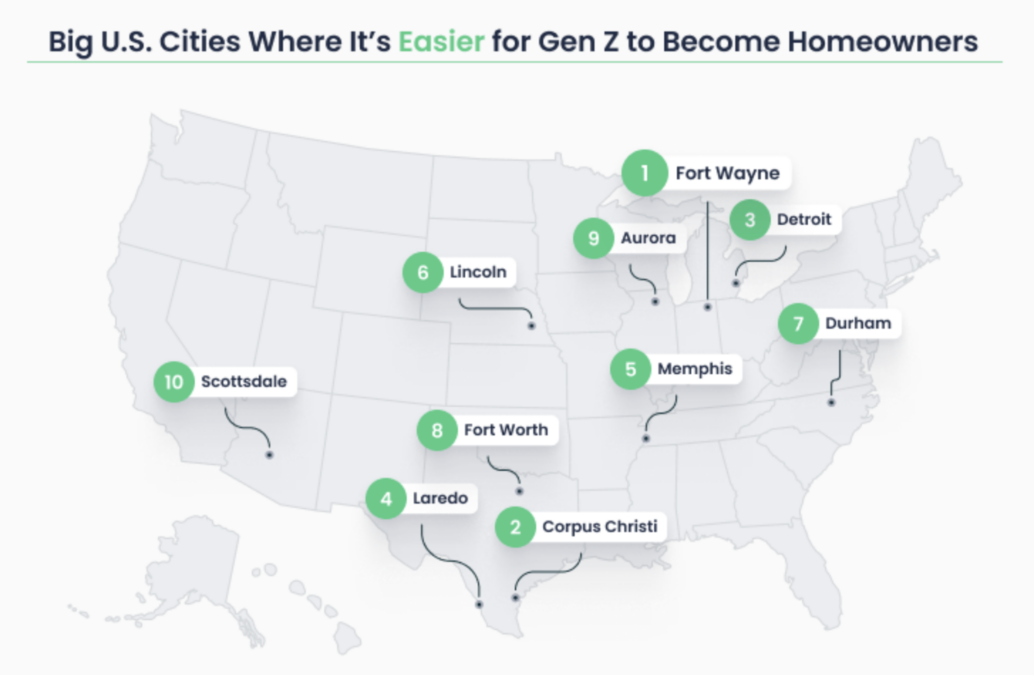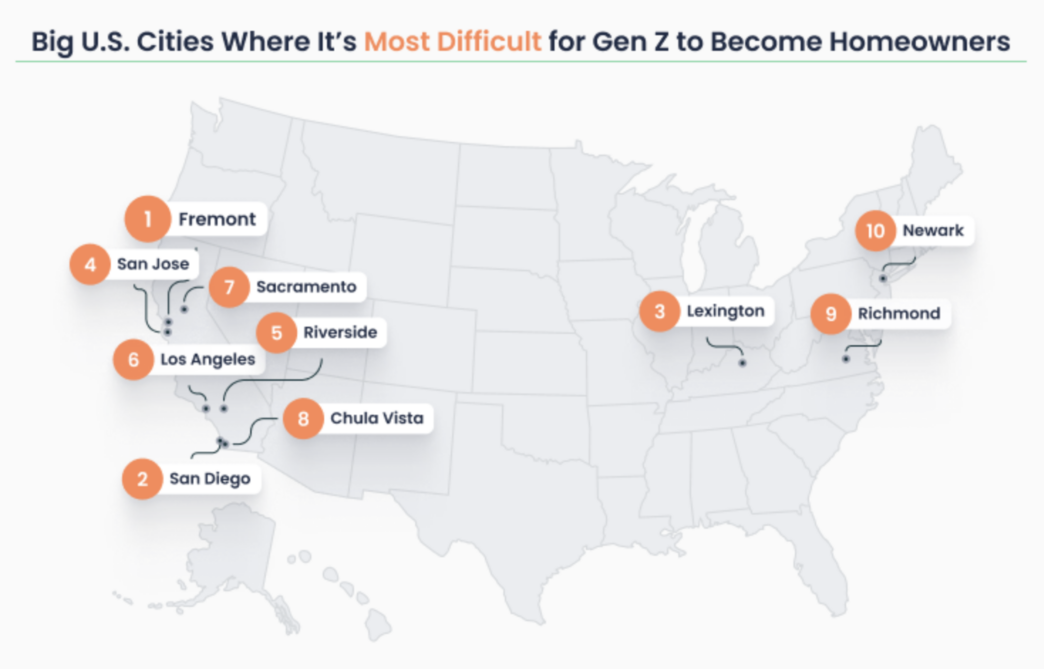With the number of Gen Zers nearing a whopping 70 million—about 21% of the U.S. population—a new study from Point2 revealed which cities have the best chance of achieving homeownership. Born between 1997 and 2012, some members of Gen Z are ready to purchase a home. But where? In which city?
So, how does the youngest American cohort go about choosing where to settle down?
Having faced a pandemic, crippling inflation, historically high mortgage rates, volatile housing markets, and an overall turbulent economy, the most recent Census data shows that the share of Gen Z householders—adults younger than 25—who own their home is less than 17%.
But on a positive note, this percentage is expected to continue to grow, alongside the demographic itself.
To assess the feasibility of Gen Z homeownership in the country’s 100 major cities (including the five New York City boroughs), Point2 ranked them based on seven metrics:
- Home Price-to-Income Ratio: to see how many household incomes (where the householder is under 25) would be needed to reach the median home price in a market.
- Median Sale Price Difference: to understand how home 2023 prices are more impactful compared to 2022.
- Inventory (per 10,000 residents): to evaluate how many housing options are available.
- Share of Homes Sold Above Listing Price—to assess bidding wars and competitiveness in a market.
- Days on Market: to determine how quickly homes fly off the market and measure competitiveness.
- Homeownership Rate: to assess the real probability of adults under 25 achieving homeownership.
- Unemployment Rate: to see where young adults have lower chances of financing homeownership.

America’s youngest homebuyers stand a better chance at homeownership in the South and Midwest.
The report found that while Gen Z’s homebuying patterns are vastly different from those of older generations growing up during a global crisis, the youngest set of Americans have a heightened focus on wellbeing. Gen Z also inherited the affordability concerns of millennials, such as student loans and the rising cost of living. With that being said, comfortability and affordability are primary concerns for Gen Zers when choosing where to buy a home.
While not in one of the most popular U.S. metros, Fort Wayne, IN, offers the highest chances of homeownership. Ranking particularly high in terms of the home price-to-income ratio and the unemployment rate among the younger segment of the population, the Summit City offers buyers a sense of financial relief.
Following is Corpus Christi, TX, where homes cost about five times Gen Z’s median income, propelling it to the top of the list of cities that make attaining homeownership easier.
Gen Zers would have the third-best chance of becoming homeowners in the Motor City—Detroit. Despite ranking in the bottom half in terms of youth unemployment rate and homes sold above listing price, the city compensates by having a 6.10% drop in home prices, the best home price-to-income ratio among all of the cities analyzed, and one of the highest homeownership rates among Gen Zers at 16.7%.
Gen Z Homeownership is "Close to Impossible" in Big California Cities and Lexington, KY.
Gen Z isn't commonly known to put down roots in expensive hubs like LA, but there has been quite a pipeline between America’s youngest potential homebuyers and Fremont, CA.
The "hardware side of the Bay" boasts million-dollar home prices are almost 23 times the average young person’s household income, yet homes are flying off the market in just 10 days—often going above the listing price. The cost of living in this exclusive city is 77% higher than the national average, having the lowest percentage of Gen Z homeowners among all the large cities analyzed.
Similarly, San Diego is no better. The housing shortage has been an ongoing issue in “America's Finest City”.
While Fremont and San Diego might not be the most desirable spots to settle down, homeownership is nearly out of reach for young people in Lexington, KY, just might. The Horse Capital of the World ranks third from the bottom, despite being a sought-after area with a median sale price lower than the national average.
While the dream of homeownership is attainable, Point2's study reinforces that there’s no perfect haven for homebuyers, let alone young ones.

The three most compelling Gen Z housing markets: Texas, California, and New York City.
Texas Rundown—How does the Lone Star State rank in terms of homeownership?
Of the 13 major Texas cities analyzed, three are among the top 10 where members of Gen Z would have a greater shot at becoming homeowners.
Corpus Christi, Laredo, and Fort Worth check off many favorable boxes for young, potential homebuyers, boasting somewhat affordable home prices below $350,000 and not that many homes selling above the asking price.
Notably, Laredo is most unfamiliar with bidding wars. Data shows that the city had zero homes sold above the asking price, despite a tight inventory that would usually drive prices higher and higher. Except for Plano (where the median home sale price saw a 12.6% hike), home prices in major Texas cities did not spiral out of control in 2023 compared to the previous year.
California Snapshot—Is the Golden State affordable for Gen Zers?
California’s red-hot housing market isn't suitable financially for Generation Z. Specifically, roughly 17 of the major cities considered in Point2's report are in California, and all of them pose challenges in Gen Z’s way to homeownership.
Fresno scores the highest in the state, although it falls somewhere in the middle of the list of major U.S. cities where Gen Z would stand a better chance at homeownership. In 2022, around 20% of young residents here will own their home, compared to 11% a year prior. Fresno is also the only California city where home sale prices fell (by nearly 2.4%).
On the other hand, sale prices in Riverside rose by almost 10%. Riverside joins Fremont, San Diego, and San Jose at the very bottom of the list. All of these cities display low homeownership rates among Gen Z, higher unemployment rates among the younger demographic, limited housing inventory, and growing sale prices.
When it comes to the home price-to-income ratio, major cities in the Golden State find themselves at the bottom once again. For instance, homes in Irvine cost almost 33 times Gen Z’s median income, while properties in San Diego and Fremont are listed for 23 times that. Although not ideal, homes in Fresno, Stockton, and Chula Vista go for almost nine times the equivalent of what Gen Z members make on average.
New York City Spotlight—The Big Apple...means bigger home prices, too?
While notoriously expensive, homeownership is a distant reality for most people in NYC—especially for those younger than 25. The notable boroughs form an accurate depiction of how hard it is for young people to chase homeownership in hip, vibrant places. Not only is lack of living space plague New York City and those looking to settle there, but most of the factors that could contribute to making ownership a dream come true are not in Gen Z’s favor.
Many homebuyers, regardless of age, do not dream of living in the luxurious city of Manhattan, where the $1,125,000 median sale price has a lot to do with it. However, just around 2% of homes sold above the asking price.
Beyond huge prices, inventory is one of the main issues in the boroughs, given the high population. Despite Manhattan having more than 7,800 active listings—more than popular metros Houston and Los Angeles—the high population ratio results in just 37 homes for sale per 10,000 people. In the Bronx, this number drops to just eight homes. But what makes the Bronx stand out is that it’s one of the few places where the median sale price dropped significantly in 2023 compared to 2022—by almost 13%, or $47,500 less.
Finally, Queens and Staten Island fall somewhere in the middle when it comes to most metrics. However, Staten Island displays one of the most significant shares of Gen Z homeowners on the list, with more than 26%.
To read the full report, including more data, charts, and methodology, click here.

 DSNews The homepage of the servicing industry
DSNews The homepage of the servicing industry









